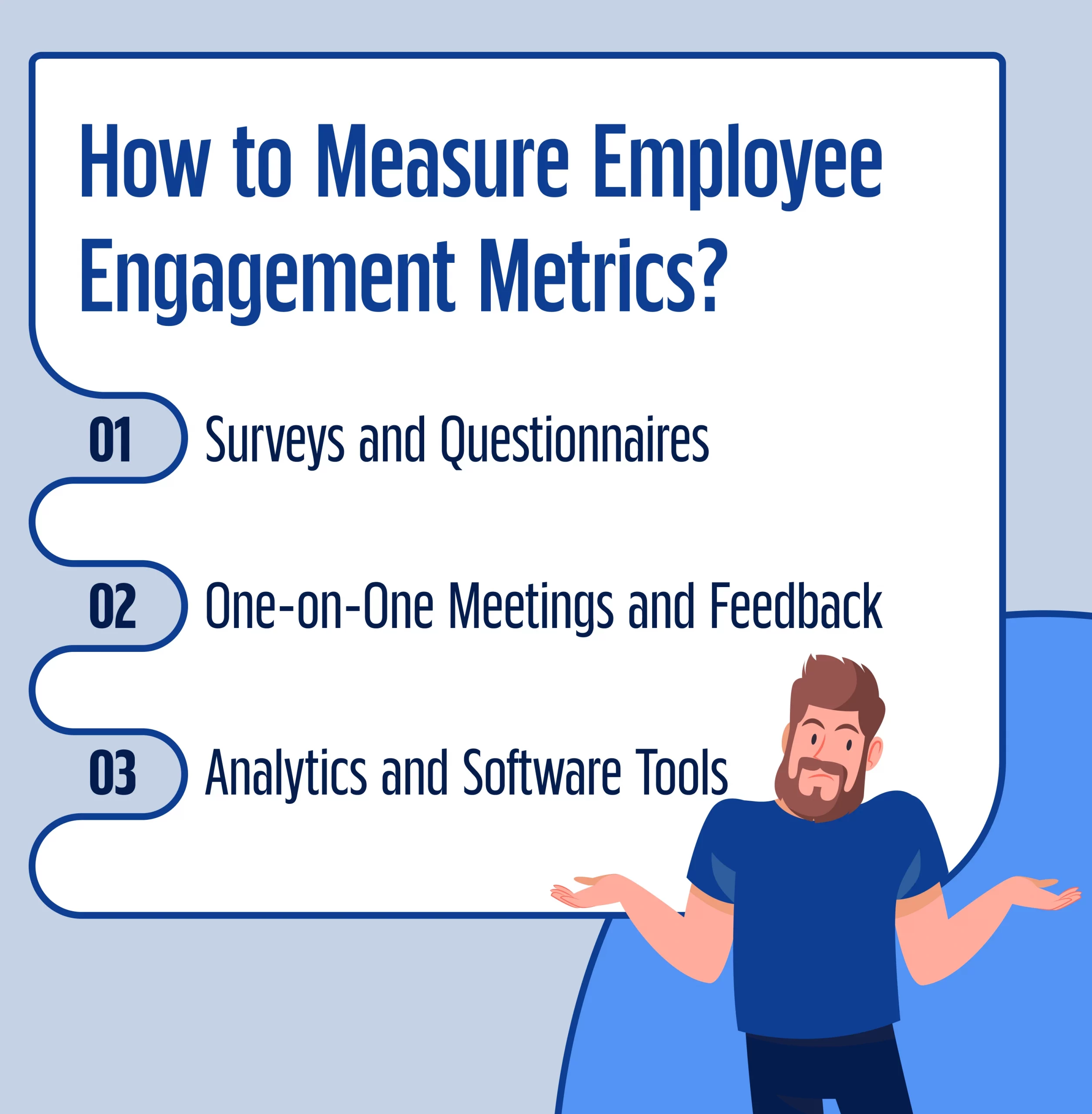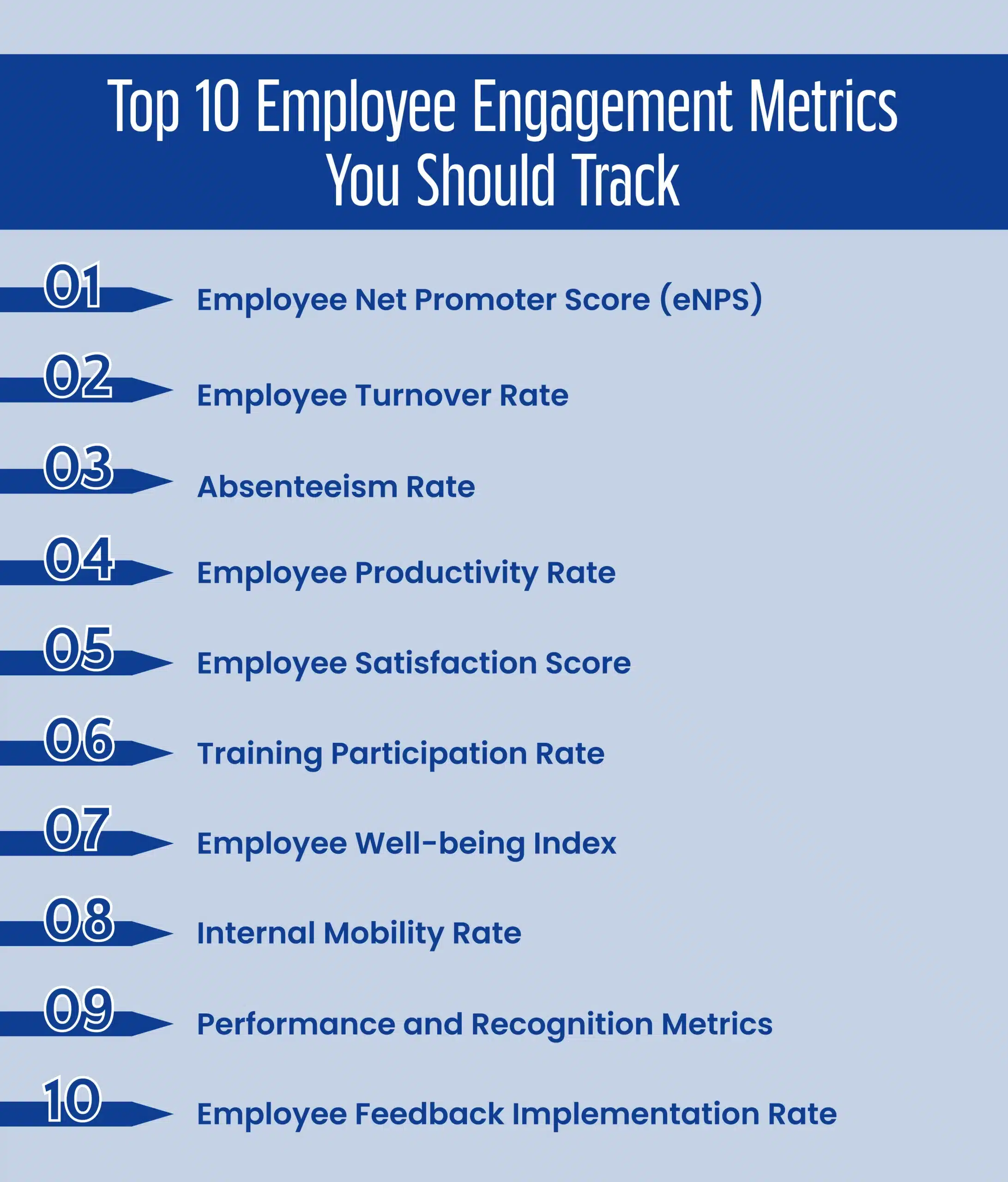Table of content
To understand your team’s engagement clearly, you should focus on tracking the right employee engagement metrics. Over the years, I’ve discovered that focusing on these metrics offers valuable insights into employee satisfaction and identifies areas for improvement.
In this blog, I’ll outline the top 10 engagement metrics you should monitor in 2024 to ensure your team remains motivated and operates at its peak performance.
What are Employee Engagement Metrics?
Employee engagement metrics are key performance indicators (KPIs) that gauge the level of enthusiasm, commitment, and emotional investment employees have toward their roles and the organization. These metrics offer valuable insights into employees’ engagement, influencing critical aspects such as productivity, job satisfaction, and overall business performance. Organizations can identify strengths and areas for improvement by analyzing engagement metrics, fostering a more motivated and high-performing workforce.
How to Measure Employee Engagement Metrics?
Measuring employee engagement metrics involves various methods, each providing different levels of insight. Here are some effective ways to measure these metrics:
Surveys and Questionnaires
Surveys are one of the most common tools for measuring employee engagement. They can be conducted annually, quarterly, or even continuously. Types of surveys include engagement surveys, pulse surveys, and exit surveys. Best practices for survey design include ensuring anonymity, asking clear and relevant questions, and acting on the feedback received.
One-on-One Meetings and Feedback
Regular one-on-one meetings between managers and employees provide a platform for open communication and feedback. These can be structured or unstructured, allowing for personalized discussions about an employee’s experience, challenges, and suggestions for improvement. This method fosters a culture of trust and continuous improvement.
Analytics and Software Tools
Various analytics and software tools can automate and simplify measuring employee engagement metrics. Popular tools include Qualtrics, SurveyMonkey, and TINYpulse. These tools offer real-time data analysis, trend tracking, and actionable insights that help make informed decisions.
Top 10 Employee Engagement Metrics You Should Track
Tracking the right metrics is crucial to measure and enhance employee engagement effectively. Here are the top 10 employee engagement metrics you should monitor:
Employee Net Promoter Score (eNPS)
eNPS gauges employees’ likelihood of recommending their workplace to friends and family. It’s calculated by subtracting the percentage of detractors (employees who would not recommend the workplace) from the percentage of promoters (those who would). This metric is a vital indicator of overall employee satisfaction and loyalty. A high eNPS suggests that employees are generally happy and committed, while a low score may highlight dissatisfaction or disengagement within the workforce.
Employee Turnover Rate
The turnover rate measures the percentage of employees who leave the organization within a specific time frame. A high turnover rate often signals employee engagement, job satisfaction, or company culture issues. Addressing high turnover involves enhancing work conditions, offering competitive salaries and benefits, and providing ample career development opportunities. Monitoring this metric helps identify trends and implement strategies to improve employee retention.

Absenteeism Rate
The absenteeism rate tracks the frequency and duration of unplanned absences among employees. High absenteeism can signify disengagement, job dissatisfaction, or personal issues. Understanding the underlying causes, such as workplace stress or inadequate support, is crucial for addressing absenteeism. Implementing measures like improving workplace conditions, offering support for personal issues, and fostering a positive work environment can help reduce absenteeism and enhance overall engagement.
Employee Productivity Rate
Employee productivity rate measures the efficiency with which employees complete their tasks and contribute to organizational goals. Engaged employees typically exhibit higher productivity levels. By tracking this metric, organizations can identify areas where employees need additional support or resources, address bottlenecks, and optimize workflows. Increased productivity is often a direct result of high engagement, making this metric a key indicator of employee motivation and effectiveness.
Employee Satisfaction Score
Employee satisfaction score evaluates how content employees are with various aspects of their job, including the work environment, management, and role responsibilities. Surveys and feedback tools are used to gather this data. A high satisfaction score indicates that employees feel valued and engaged, while a lower score may reveal areas requiring improvement. This metric helps distinguish between general job satisfaction and deeper engagement factors, providing insights into overall employee well-being.
Training Participation Rate
The training participation rate measures the percentage of employees engaging in learning and development programs. Continuous learning is essential for employee growth and engagement, as it helps employees acquire new skills and advance their careers. Tracking this metric ensures that employees actively participate in training opportunities, which can enhance their job satisfaction and commitment to the organization. A high participation rate often correlates with a strong culture of professional development.
Employee Well-being Index
The employee well-being index assesses employees’ overall physical, mental, and emotional health. It includes factors such as stress levels, work-life balance, and access to wellness resources. A high well-being index indicates that employees are generally healthy and balanced, contributing to higher engagement and productivity. Organizations should prioritize initiatives that support employee well-being to maintain a positive and productive work environment.
Internal Mobility Rate
Internal mobility rate tracks the frequency at which employees move within the organization, whether through promotions or lateral transfers. High internal mobility reflects a dynamic and healthy work environment where employees have career growth and development opportunities. This metric is crucial for retaining top talent and ensuring that employees remain engaged by offering them new challenges and responsibilities within the company.
Performance and Recognition Metrics
Performance and recognition metrics measure how often employees receive recognition for their work and how their performance aligns with set goals. Regular recognition and feedback are essential for boosting employee morale and engagement. These metrics help track individual and team contributions, ensuring employees feel valued and motivated. Recognizing and rewarding employees for their achievements fosters a positive work culture and enhances engagement.
Employee Feedback Implementation Rate
Employee feedback implementation rate measures the effectiveness with which employee feedback is acted upon. Gathering feedback is only beneficial if it leads to tangible improvements and changes. Tracking this metric ensures that the organization values employee input and is committed to addressing their concerns. A high implementation rate indicates that feedback is used constructively, which can significantly enhance employee engagement and satisfaction.
Conclusion
Keeping track of the right employee engagement metrics is essential for fostering a motivated and productive workforce. By focusing on these top 10 metrics in 2024, you’ll gain valuable insights into how your team feels about their work and how you can enhance their overall experience. Regularly monitoring and acting on these metrics will help you address potential issues, improve job satisfaction, and ultimately drive better organizational performance.
As you build a more engaged team, remember that having the right talent on board is crucial. If you’re looking to hire exceptional software developers who can elevate your projects and drive success, Supersourcing is here to help. Contact us today to connect with top professionals who fit your needs and contribute to your team’s growth.
FAQs
-
Why are employee engagement metrics important?
Employee engagement metrics help organizations understand how motivated and committed their employees are, directly impacting productivity, retention, and overall business performance.
-
What is the difference between employee engagement and satisfaction?
Employee satisfaction refers to how content employees are with their jobs, while engagement measures their emotional investment and motivation to contribute to the company’s success.
-
How can surveys improve employee engagement?
Surveys provide a structured way to gather employee feedback, identify issues, and implement improvements, fostering a culture of continuous improvement and engagement.
-
What role do one-on-one meetings play in measuring engagement?
One-on-one meetings facilitate open communication, allowing managers to address individual concerns, provide support, and strengthen the employee-manager relationship.
-
How can organizations reduce high turnover rates?
Organizations can reduce turnover by improving work conditions, offering competitive benefits, providing career development opportunities, and fostering a positive workplace culture.


